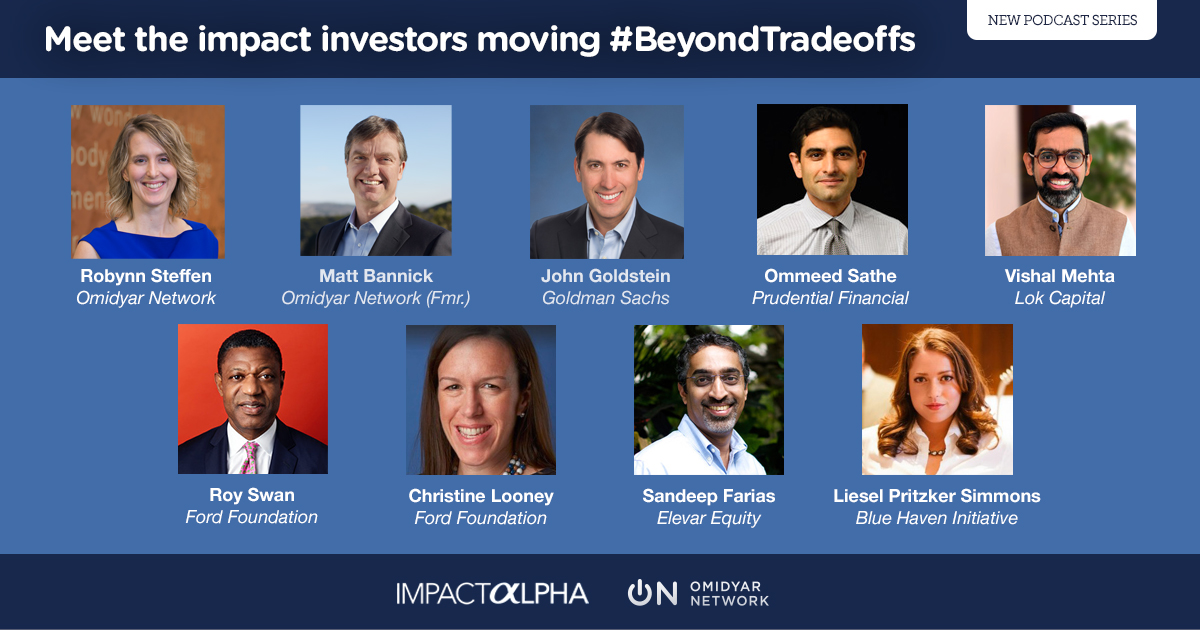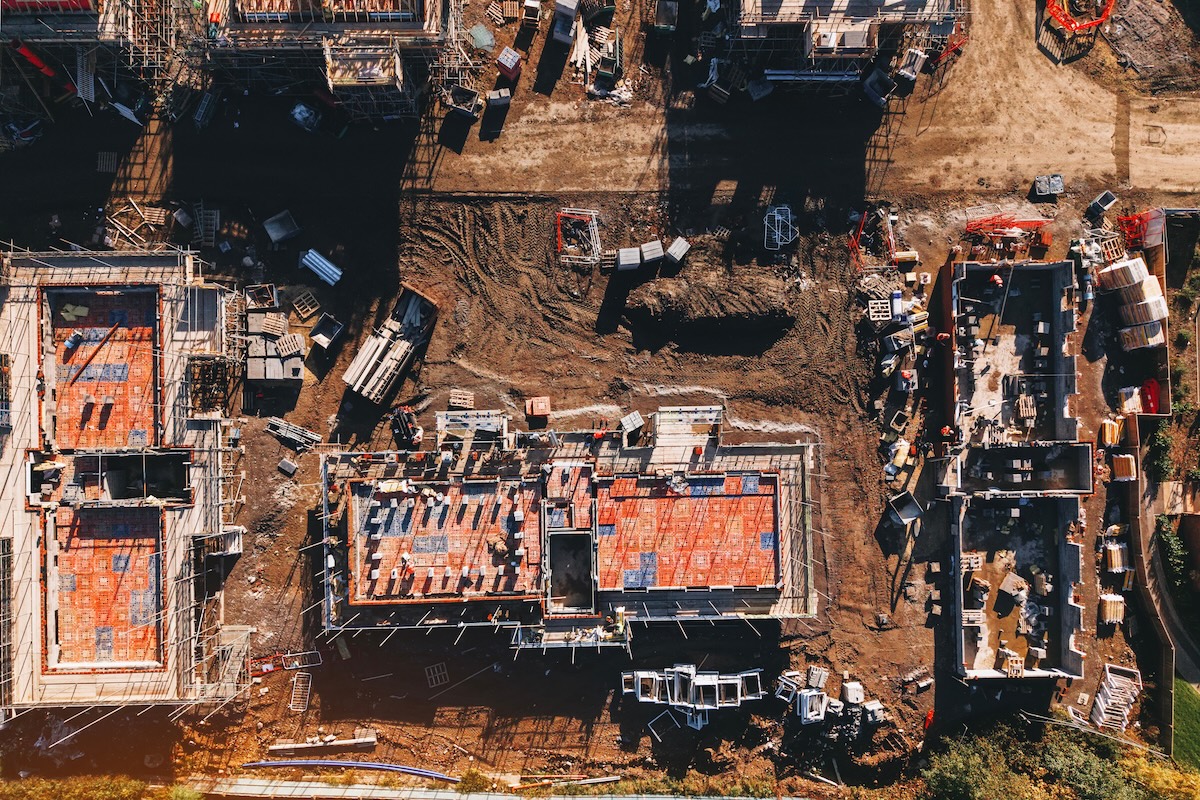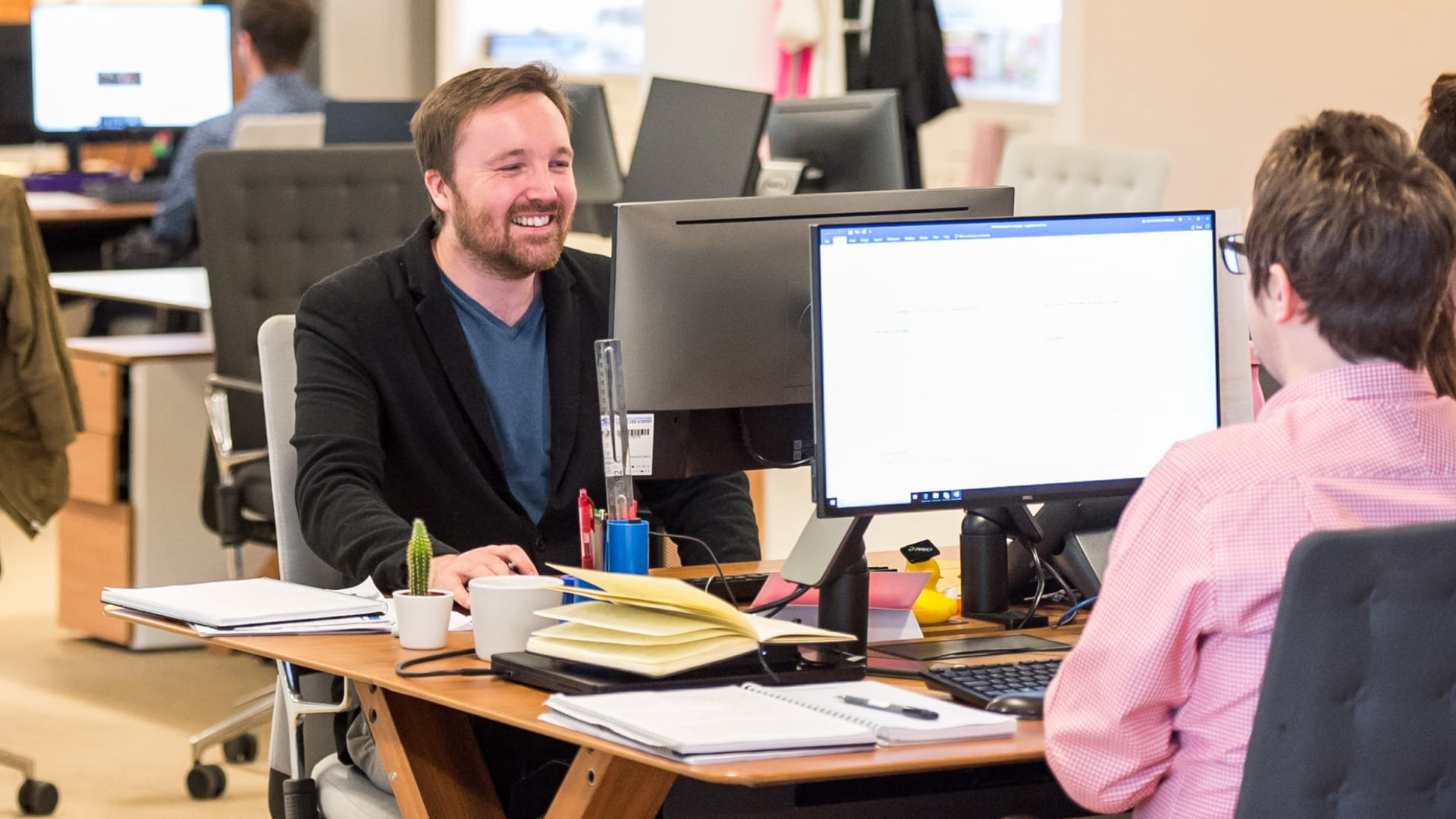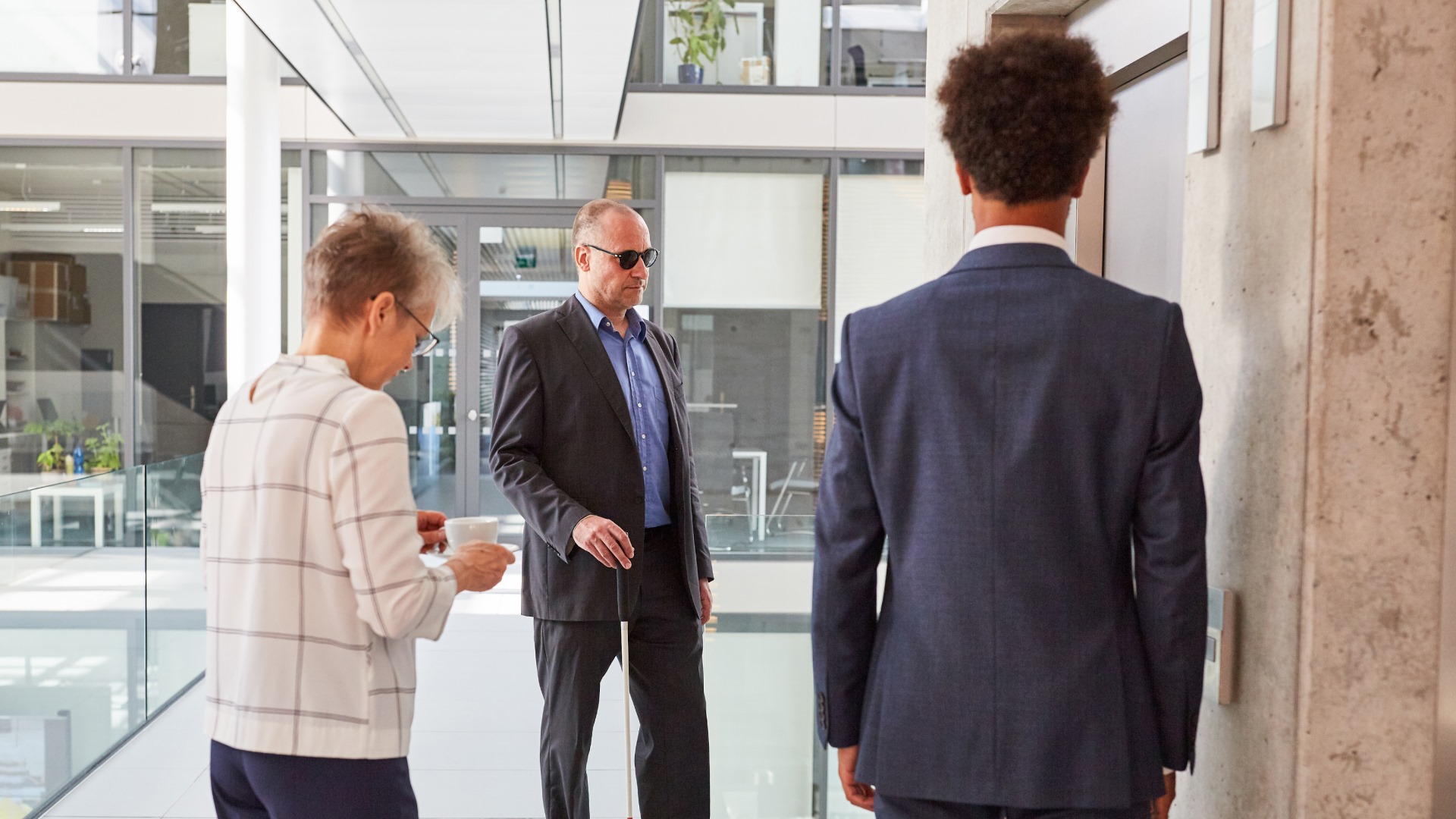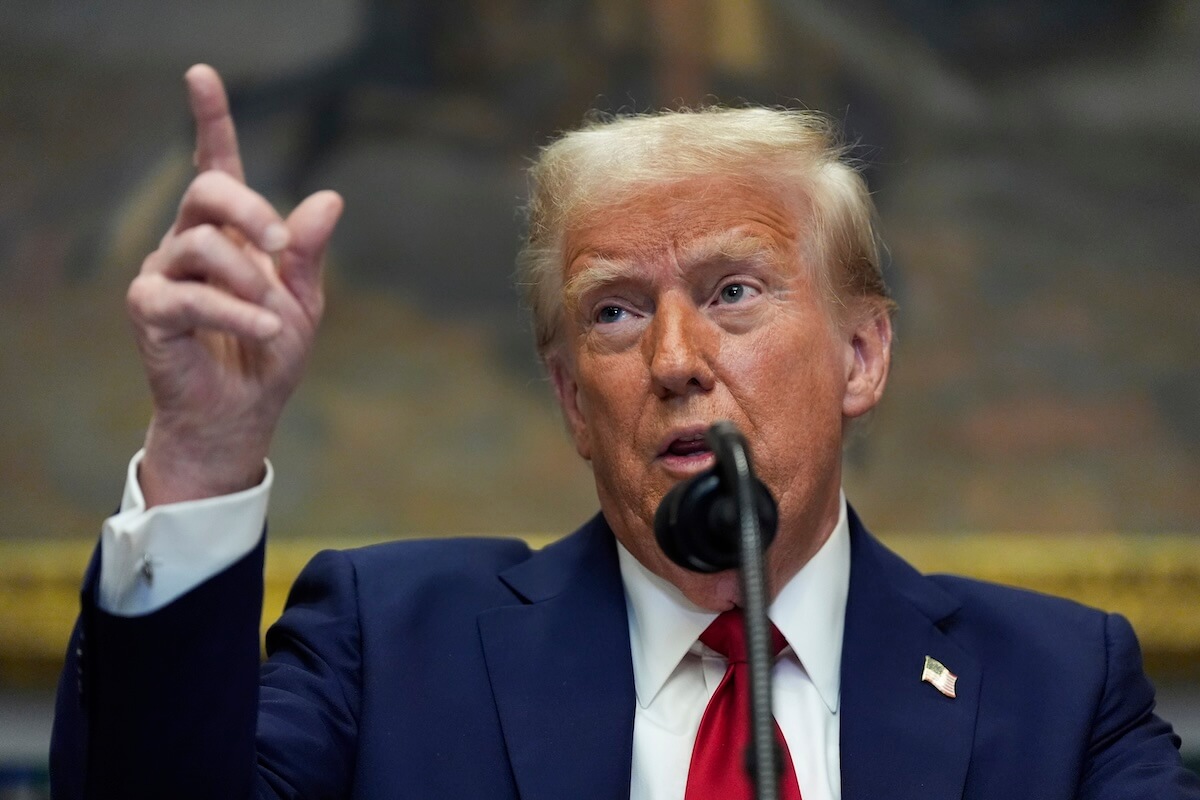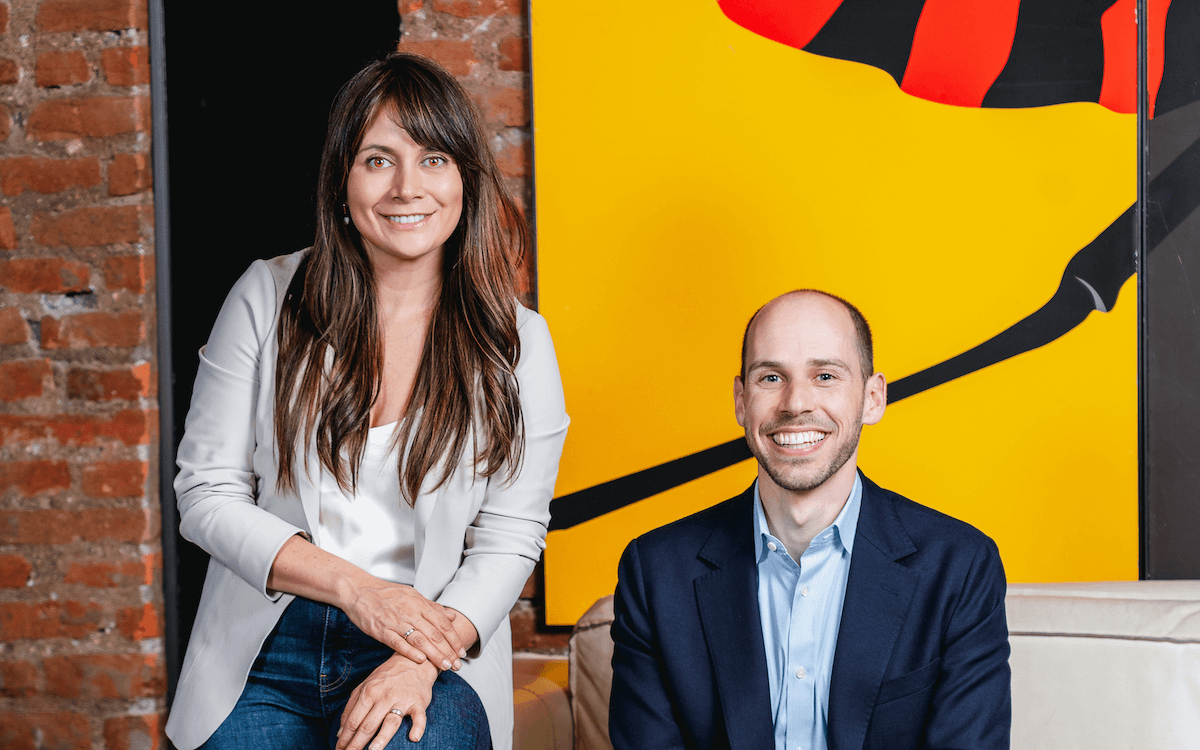Beyond Trade-offs is an ImpactAlpha podcast series, produced in partnership with Omidyar Network, in which impact investors look across the returns continuum at investment strategies to scale capital for impact.
- Interactive infographic. Explore each investor’s portfolio along the continuum of returns.
- Catch up. Take a spin through the full “Beyond Trade-offs” podcast series.
- Don’t miss an episode. Subscribe to ImpactAlpha’s podcasts on iTunes, Spotify, SoundCloud or Stitcher.
- Read the collection of essays on The Economist digital hub last year.
ImpactAlpha, May 6 – In The Land Beyond Trade-offs… investors know their own objectives for social and environmental impact, and craft investment strategies and portfolios that fit their unique appetites for risks and returns.
As ‘impact’ becomes an integrated part of investment decision-making, an outdated notion of a necessary and permanent trade-off between social benefits and private returns is giving way. Leading investors, both commercial and catalytic, are deploying dynamic, integrated strategies across assets and across portfolios.
In a new series of podcasts produced in collaboration with Omidyar Network, ImpactAlpha asked a range of investors, from fully “market-rate,” to unapologetically concessionary, what lies… Beyond Trade-offs.
What we heard is that investors of all types are finding strategies to avoid specific and systemic risks, to be aligned with long-term trends, to generate tangible and measureable social and environmental benefits and to otherwise meet their objectives – all along the continuum of risks and returns.
Across the continuum
What lies beyond trade-offs is an integrated “risk-return-impact framework,” says Goldman Sachs’ John Goldstein. Impact strategies and an analysis of environmental, social and governance factors can help investors manage downside portfolio risks, tap hidden sources of value and ride social and environmental trends that remain underappreciated by other investors.
For Ommeed Sathe of Prudential Financial, it’s a clear-eyed view of risk-adjusted returns, and which portfolio they fit. Eighty percent of Prudential’s nearly $1 billion impact investing portfolio is invested in sectors with fully risk-adjusted market rates of returns; 20% goes to higher-risk activities with the potential to generate outsized impact.
Beyond trade-offs lay “more shades of gray,” Lok Capital’s Vishal Mehta told us, recounting the Bangalore-based fund’s efforts to build investment ecosystems in microfinance, education and healthcare, backed by commercial and development-finance limited partners – and grants to provide technical assistance to portfolio companies.
Roy Swan and Christine Looney, who are managing Ford Foundation’s $1 billion mission-related mandate from its $13 billion endowment, are demonstrating that beyond trade-offs lies more capital to advance social justice. The sweet spot: sectors such as affordable housing and quality jobs, in which the market has mispriced risks.
Massive scale at profitable margins goes well beyond trade-offs for Elevar Capital’s Sandeep Farias. The key to keeping profits and purpose aligned: an entrepreneurial focus on the world’s largest customer base – low-income communities around the world with growing demand for affordable, high-quality products and services.
High-net worth families have particular flexibility to allocate the right capital for the job, says Liesel Pritzker Simmons of the Blue Haven Initiative, which invests its more than $500 million portfolio across the continuum from fully commercial to fully concessionary, with a portion reserved for venture-style bets in high-impact, high-risk sectors such as off-grid electricity in Africa.
The Omidyar Network has made it a priority to help investors navigate the increasingly sophisticated landscape. That work includes a taxonomy, first introduced in Across the Returns Continuum, mapping returns from fully commercial investments to fully concessionary grants. Last year, Omidyar enlisted leading investors to describe their own Beyond Trade-offs strategies in a collection of essays, published on The Economist digital hub.
To deepen the discussion, Omidyar Network has partnered with ImpactAlpha to produce a series of podcast interviews with some of those same investors, accompanied by a new infographic that maps their portfolios across the continuum.
Unlocking hundreds of billions—and then trillions—of dollars to address urgent local and global challenges, from poverty to climate change, requires all of those kinds of investors and more, says Omidyar Network’s Robynn Steffen. “Once we move beyond trade-offs, we can really mobilize all types of capital for complex challenges,” she says in the first episode of the podcast series.
Big Tent
Pension funds, insurance companies, foundations and high net worth (HNW) families, along with fund and wealth managers, arrive at this historic juncture from different directions, with their own expectations and constraints.
“Our message would be, ‘See the full continuum of capital and be intentional about where you play,'” Steffen says. “The challenge is not only to crowd everyone into the big tent, but also to empower and inspire asset owners to align their capital with the market segments best poised to deliver on their unique expectations for risk, return and impact.”
>>Interactive infographic: Touch or click each button below to see more details about each investment strategy
Omidyar Network, backed by eBay founder Pierre Omidyar and his wife, Pam, is in many ways its own big tent. Part family office, part venture capital fund, part philanthropic nonprofit, Omidyar Network has committed nearly $1.5 billion in investments and grants and was an early part of the movement of tech moguls into strategies for social change.
In its early years, Omidyar Network had only two buckets of return-expectations for its investment, fully market-rate, on a risk-adjusted basis from its for-profit LLC; and fully concessionary grants that carried no expectation of returns, from its nonprofit foundation. Omidyar feared that loosening constraints on returns might invite sloppy investments or distort markets, Omidyar’s former managing director, Matt Bannick, explains in the podcast. Bannick, Steffen and new managing partner Mike Kubzansky co-authored Omidyar Network’s introduction to the Beyond Trade-offs series in The Economist.
In practice, Omidyar’s teams, particularly in emerging markets, found that kickstarting markets for positive social impact sometimes required taking outsized risks or accepting lower returns. When Omidyar took its nuanced approach public, it met with various forms of cognitive bias.
“The question would be framed, ‘Is there a trade-off between returns and impact?’ You would have some people say, ‘Yes!’ Some people say, ‘No!’ And others and ‘yes,’ and ‘no,’” says Bannick.
Getting “beyond trade-offs” doesn’t mean such trade-offs don’t exist. It means getting beyond the increasingly sterile debate about trade-offs that may be stalling what could be a transformational shift of capital.
“Confused capital stays on the sidelines,” Steffen says. “It decides to wait it out.”
Some commercial investors have been scared off by a perception that impact investments are invariably concessionary, sloppy or really philanthropy dressed up as investing. The perception allows them to dismiss impact investors as ‘good people doing bad deals,’ as rock-star-turned-investor Bono once sniffed. Some market segments – think affordable housing or inclusive financial services – may require no trade-off between positive social impact and risk-adjusted market rates of return.
Conversely, deeming only fully risk-adjusted, market-rate investments to be “serious” investments risks driving away philanthropic and other providers of crucial concessionary or “catalytic” capital. Nascent markets, with unproven models and in particular, those that serve low-income customers – may require capital that is explicitly prepared to make a concession, in the form of higher risk, longer repayment or lower returns.
Such capital is in the shortest supply. Compared to the tens of trillions in commercial capital, and hundreds of billions in philanthropic capital for grants, capital to de-risk deals, bet on first-time fund managers, and target tough geographies and hard-to-reach customers may total only in the low billions.
“One of the things that is going to be really critical is to see catalytic capital flow into the market,” Steffen says, and to “to see catalytic capital fulfill its full potential in terms of being able to crowd in commercial investments, which is one of the ways it is so essential to the growth of the field.”
Omidyar Network, along with the MacArthur and Rockefeller Foundations, last month launched the Catalytic Capital Consortium to foster such sophistication and rigor. MacArthur committed $150 million to fund a roster of investments that demonstrate where concessionary capital can be most effective.
Call to action
Helping all kinds of investors find strategies that shift capital toward social impact while meeting their own objectives could finance change on a scale that dwarfs philanthropy or government.
The increasingly sophisticated market for “sustainable,” “impact” or “ESG” (for environmental, social and governance factors) investing includes a diversity of strategies for capital seeking returns across the risk-adjusted continuum.
For institutional investors, “my message would be ‘Come in off the sidelines,’” Steffen says. “Really seek out these sectors where impact goes hand in hand with financial returns, or can even mitigate risks on the horizon.”
Even investors who don’t have the flexibility to make a concession, can add impact in the form of active engagement. “What are the things they can do to enhance the likelihood that investment generates not only outsized returns but outsize impact?” Bannick asks. (The Impact Management Project offers a catalog of such investor contributions.)
Philanthropic foundations, which globally command assets of more than $1.5 trillion, “can’t afford to leave that impact on the table,” Steffen says. “We’re talking about endowments here.”
High-net-worth families, like the Omidyars themselves, have perhaps the greatest responsibility to drive the shift of capital, because they have the most flexibility in deploying their own capital, Steffen says. “Families have to be on the front lines of bearing the risk of early-stage innovation and fueling impact in the toughest market segments.”
A commitment to high-impact, catalytic investments could be one response to rising concerns over the increasing concentration of wealth, Bannick says.
“People who are in the position of having significant wealth and who want to have impact – and many, many of them do – should avail themselves of all the tools in the toolkit,” he says. “They should be thinking clearly about what issues they care about, where they want to play, and what kinds of capital they can deploy in service of having impact.”



